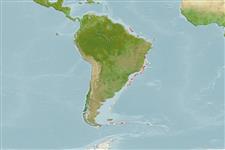Environment: milieu / climate zone / depth range / distribution range
Ekologi
laut batidemersal; kisaran kedalaman 229 - 411 m (Ref. 13707). Deep-water
Southwest Atlantic: known only from off the Atlantic coast of northern Brazil.
Size / Weight / umur
Maturity: Lm ? range ? - ? cm
Max length : 14.0 cm SL jantan/; (Ref. 52964)
Life cycle and mating behavior
Kematangan | Reproduksi, perkembang biakan | Pemijahan | telur-telur | Fecundity | Larva
Fricke, R., 1992. Revision of the family Draconettidae (Teleostei), with descriptions of two new species and a new subspecies. J. Nat. Hist. 26(1):165-195. (Ref. 13707)
Status IUCN Red List (Ref. 130435: Version 2024-1)
ancaman kepada manusia
Harmless
penggunaan manusia
Alat, peralatan
laporan khas
muat turun XML
Sumber internet
Estimates based on models
Preferred temperature (Ref.
123201): 3.4 - 6.7, mean 4.6 °C (based on 30 cells).
Phylogenetic diversity index (Ref.
82804): PD
50 = 0.5001 [Uniqueness, from 0.5 = low to 2.0 = high].
Bayesian length-weight: a=0.00389 (0.00180 - 0.00842), b=3.12 (2.94 - 3.30), in cm total length, based on all LWR estimates for this body shape (Ref.
93245).
Trophic level (Ref.
69278): 3.3 ±0.5 se; based on size and trophs of closest relatives
Fishing Vulnerability (Ref.
59153): Low vulnerability (10 of 100).
